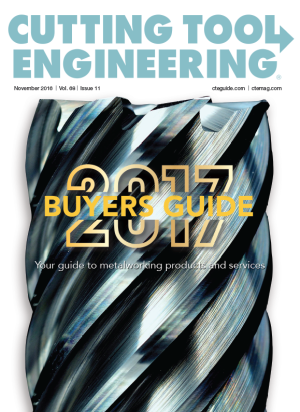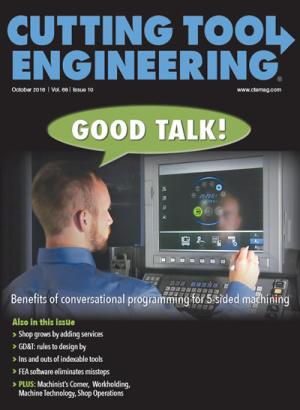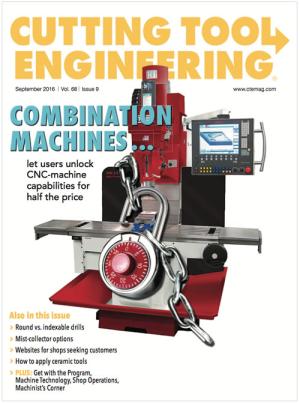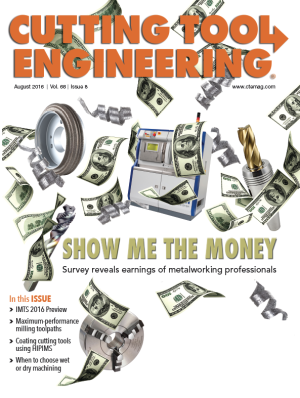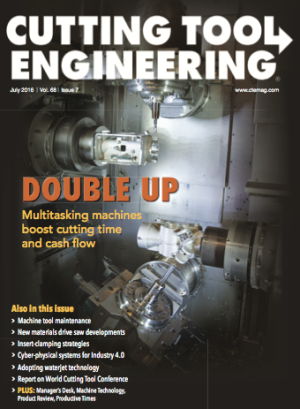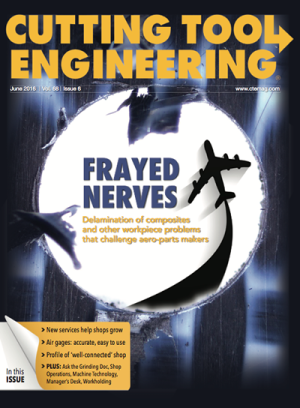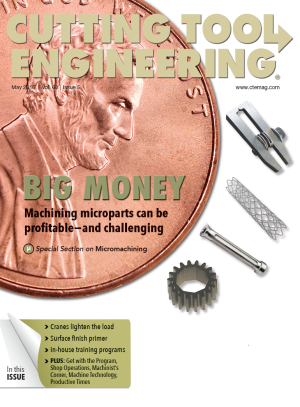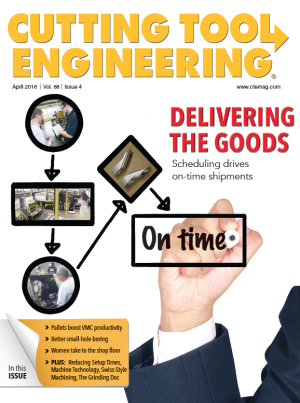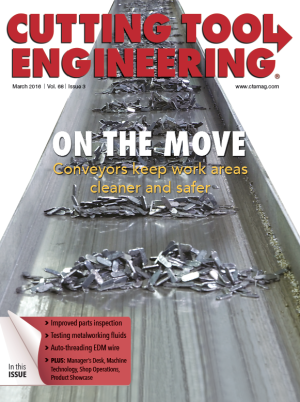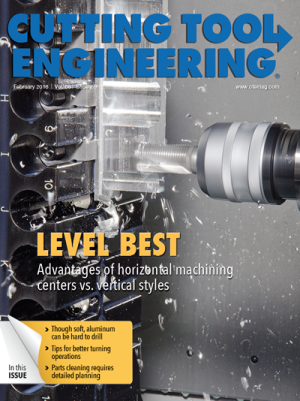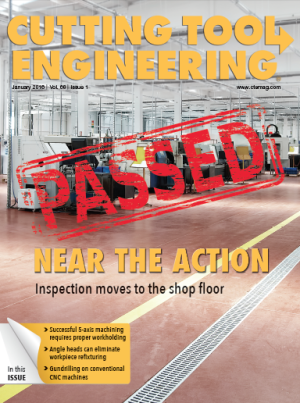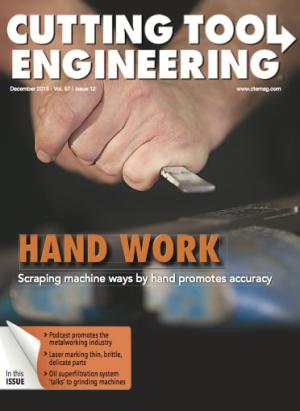Cutting Tool Engineering's annual Buyers Guide issue.
Cutting Tool Engineering Magazine
Cutting Tool Engineering magazine, published 12 times a year by CTE Publications Inc., helps manufacturing professionals enhance the productivity of their companies' cutting and grinding operations, and provides essential insights for machining professionals. Browse through our digital issue archive below and select the digital format you prefer: via our Cutting Tool Engineering app, a PDF file, or an interactive digital edition that can be viewed on any device by visiting digital.ctemag.com.
Get Your Printed Back Issues of CTE – Order Now!
Issue Archive
The October 2016 issue addresses the benefits of conversational programming for 5-sided machining. PLUS:
- Pros and cons of indexable tools
- Manager's Desk: Navigating customer portals
- Titanium Cutting Simplified
- 3D Printing, To Infinity and Beyond
- Lead Angle: In Screen We Trust
- Shop Operations: Becoming Familiar With Code
- Workholding: Mod Squad
- Machinist's Corner: Improving Daily Management
- Machine Technology: Sound Shakes Up Machining
- Get With The Program: Bring on the Heat
- Engineer-Speak
- Shop Profile: Seco Machine on the right track
- Finite element analysis in the supply chain
- Titanium Cutting Simplified
- 3D Printing, To Infinity and Beyond
Combination machines bridge the gap between manual and CNC equipment. PLUS:
- Lead Angle: Overcoming the skills gap
- Ceramic composite cutting tools: are they tough enough?
- The evolving technology of tool presetting
- Proper mist collection necessary for shop floor safety
- A tale of two cutting tools: solid and indexable-insert drills
- Net/Working with specialty subscription websites
- Get With The Program: Generate consistent and accurate pricing with cost-estimating software
- Machine Technology: Rotary unions help deliver coolant to the cutting zone
- Shop Operations: Benefits of becoming familiar with CAM software
- Machinist's Corner: IMTS is the place to check your wish list
- Hand-in Glove Robotic Technology
- (Polyn)urban Renewal
"Deflated Earnings," the cover story in our August 2016 issue, reveals the paychecks metalworking professionals receive are not packing as much punch. PLUS:
- Lead Angle: We are going to the show
- Maximum-performance milling outperforms traditional milling by a long shot
- Making light work
- One PVD coating technique with certain advantages
- Which is better: dry or wet machining?
- Multiple methods are available for deburring holes
- Single-point thread programming can be fun and easy
- PCD reamers offer long tool life and productivity gains while reducing secondary operations
- Productive Times: One-shot wonder
- Productive Times: Rotary table speeds production
- Manager's Desk: An unexpected role
- Get With The Program: Monitoring machines in real time
- Machine Technology: Short pulses offer long-term gains
- Shop Operations: Becoming familiar with CAD
- Ask The Grinding Doc: Grinding sensitive parts
- A strong, but light-load-bearing metal nano-composite
- A new tooling, software combination to speed blisk production
"Multibenefit Machines," the cover story in our July 2016 issue, looks at how multitasking machines boost cutting time and cash flow. PLUS:
- Clamp Down
- Cutting Remarks
- High-Pressure Work
- A Simple Diagnosis
- Coming Revolution
- Manager's Desk: Customer visit is striking
- Machine Technology: Systems for avoiding or mitigating machine tool crashes
- Talking Shop: Drilling expert Greg Forman discusses deep-hole drills
- Shop Operations: Importance of communication between engineers and shop personnel
- Machinist's Corner: How to address manufacturing's image problem
"Flying-Machine Machining," the cover story in our June 2016 issue, delves into the delamination of composites and other workpiece problems that challenge aerospace parts makers. PLUS:
- Airing differences
- Above and beyond
- Data-driven manufacturing
- Manager's Desk: Take a strategic approach to golden opportunities
- Machine Technology: Portable drill machine for multilayer materials
- Workholding: Benefits of an innovative quick-change jaw system
- Shop Operations: Importance of interaction between machinists and engineers
- Ask the Grinding Doc: Options when grinding cams
"Big Money—Small Times," the cover story in our May 2016 issue, takes a closer look at the potential profitability of machining microparts. PLUS:
- Challenges in the micro-EDM world
- Benefits of laser-based micromachining
- Terms of the trade for surface roughness measurement
- Manufacturers see value of investing in training
- Moving large, complex parts calls for specialized equipment
- Manager's Desk: Managing worker illnesses and deaths
- Machine Technology: Latest developments in machine tool lubrication
- Shop Operations: Challenges of chamfering and edge dressing
- Get With The Program: Implementing CAM strategies for barrel cutters
- Machinist's Corner: Where have all the apprenticeship programs gone?
The April 2016 cover story, "Right on Time," addresses accurate shop floor scheduling—often hard to achieve, but nonetheless important. PLUS:
- Pallet-changing systems help VMCs hold their own in production environments.
- Troubleshooting solid-carbide boring bars requires the right diagnosis
- Reducing setup time provides more time for making chips.
- Women are playing an increasingly important role in manufacturing.
- Manager's Desk: Strategies for handling an uptick in business.
- Machine Technology: Jig borers are highly accurate "mother machines."
- Shop Operations: Advantages of rigid workholding.
- Swiss-Style Machining: A comparison of turret-mounted and gang-style, slide-mounted toolholders.
- Ask the Grinding Doc: Madness surrounds grinding wheel tests.
"Chips Away," the March 2016 cover story, covers central conveyor systems that declutter shops and make them safer. PLUS:
- Better Threaders: Automatic threaders for wire EDMs have made significant advancements.
- Testing, Testing ... How often should you test metalworking fluids?
- Controlling the Process: Careful consideration can yield efficiencies when implementing inspection processes.
- Product Showcase: New products for the metalworking industry.
- Manager's Desk: Simple ways to improve employee morale.
- Machine Technology: Benefits of a good spindle maintenance program.
- Shop Operations: More ways to avoid machine tool crashes.
- Get With The Program: Enhancing competitiveness with asset-monitoring software.
- Machinist's Corner: Importance of evaluating nonconforming parts with a material review board.
"HMC Payoffs," the February 2016 cover story, looks at how horizontal machining centers' enhanced capabilities shorten payback periods. PLUS:
- Overcoming five common challenges faced when turning.
- Component cleanliness requires effort throughout the manufacturing process.
- Aluminum can be hard to drill—despite its easy-to-machine reputation.
- When the application calls for it, a reamer can be the most cost-effective way to achieve accurate hole geometry.
- Successful machine shops benefit from personal relationships.
- Combining additive and subtractive manufacturing in a VMC.
- Ways to avoide machine tool crashes.
- Tips for gripping threaded parts.
- Dressing grinding wheels with PCD.
Metrology is evolving to allow inspection to be moved closer to the production area. PLUS:
- The right workholder is critical for success when 5-axis machining.
- Angle heads let cutting tools reach more of the workpiece.
- Gundrilling on conventional CNC machines.
- An overview of a machine tool developed for Industry 4.0.
- Multitask machine tools proliferate as manufacturers seek to reduce setup time.
- CAD/CAM developers strive to enhance UX—the user experience.
- Beware of job recruiters and placement companies.
Whether done manually or with a powered device, scraping guide ways is critical to machine tool performance. PLUS:
- Two metalworking professionals breakdown the manufacturing industry with their "Making Chips" podcast.
- Laser technology allows for precise, noncontact marking of thin, brittle or otherwise delicate parts without compromising part integrity.
- Learn details about the numerous new products manufacturers are offering the metalworking industry.
- And columns that address taking the time to focus on the positives; the benefits of creating and using a virtual machine tool; the importance of mastering fundamental turning skills; how planning is critical when operating CNC machines; how not to experience grinding burn; and a Q&A with Harvey Tool CEO Pete Jenkins.



